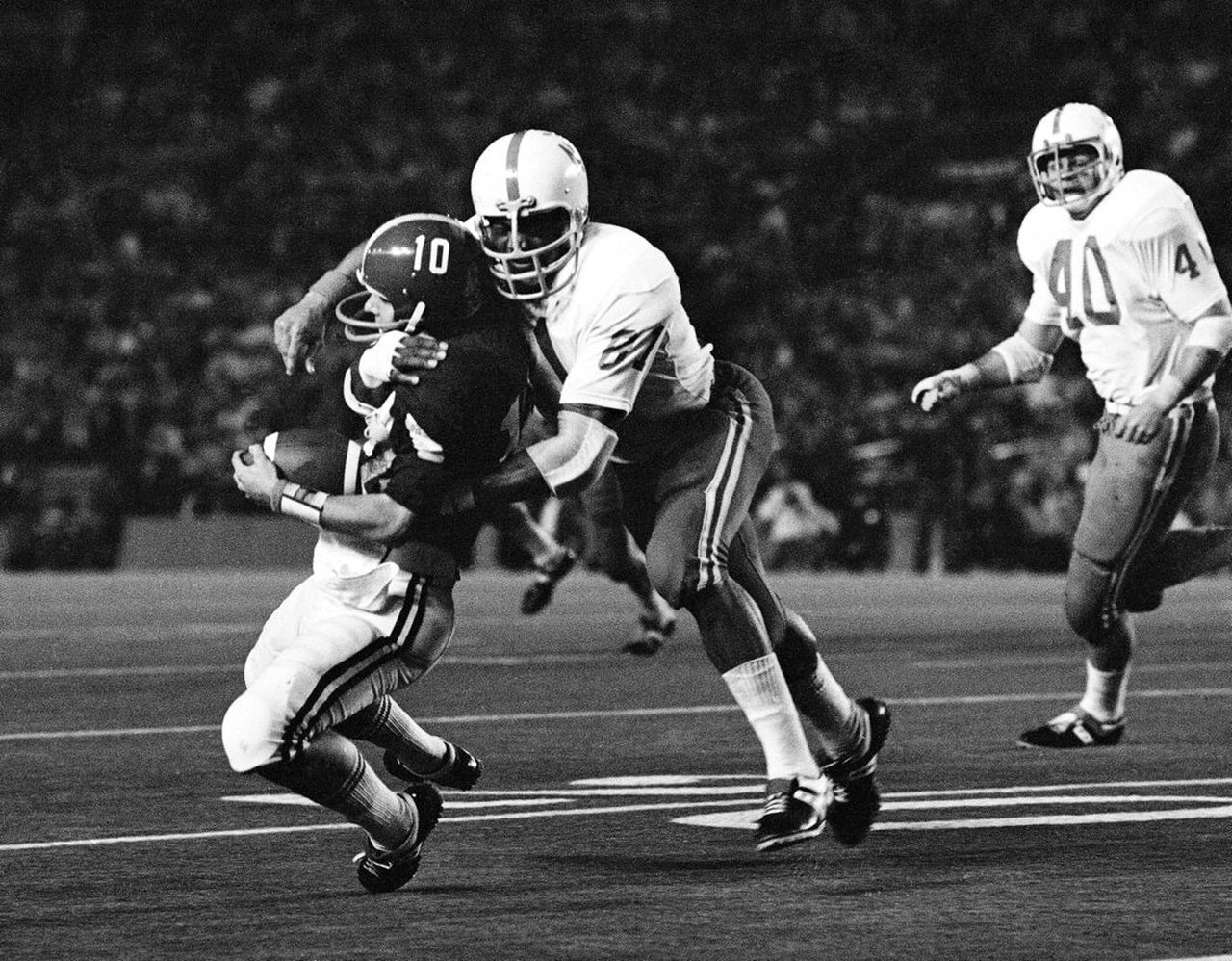Can Georgia three-peat? Here are 6 teams that tried
Winning back-to-back college football national championships is quite an accomplishment.
In the modern (post-integration) era of the sport, just seven teams have accomplished what Georgia did on Monday night. The Bulldogs smashed TCU 65-7 in Los Angeles to claim their second straight national title.
RELATED: Georgia’s Nolan Smith: ‘They thought we were gonna go 7-5′
But winning three in a row? Nigh impossible.
In the poll era (since 1936) no team has managed a “three-peat” in college football, and only one has come all that close. Here’s what happened to the last six FBS teams that tried:
Alabama quarterback Terry Davis (10) is given rough treatment in the fourth period of Saturday, Jan. 1, 1972 Orange Bowl game in Miami by Nebraska defensive end Willie Harper. Nebraska won the Orange Bowl game 38-6. (AP Photo)ASSOCIATED PRESS
1. 1972 Nebraska
Bob Devaney’s Cornhuskers went 11-0-1 and claimed the AP title in 1970, their only blemish a 21-21 tie vs. USC in Week 2 (Texas was voted No. 1 in the other major poll, conducted by United Press International). Nebraska’s team the following year was one of the best in college football history, finishing 13-0 and ending up ranked No. 1 in both polls. Among the Cornhuskers’ victories were a 35-31 win at No. 2 Oklahoma in the “Game of the Century” on Nov. 25, and a 38-6 rout of unbeaten Alabama in the Orange Bowl. Nebraska began the 1972 season ranked No. 1, but lost 20-17 at UCLA in the season opener. The Cornhuskers also tied Iowa State 23-23 and lost to Oklahoma 17-14 in November before crushing Notre Dame 40-6 in the Orange Bowl to finish 9-2-1 and No. 4 overall. Unbeaten USC claimed the championship in both polls.
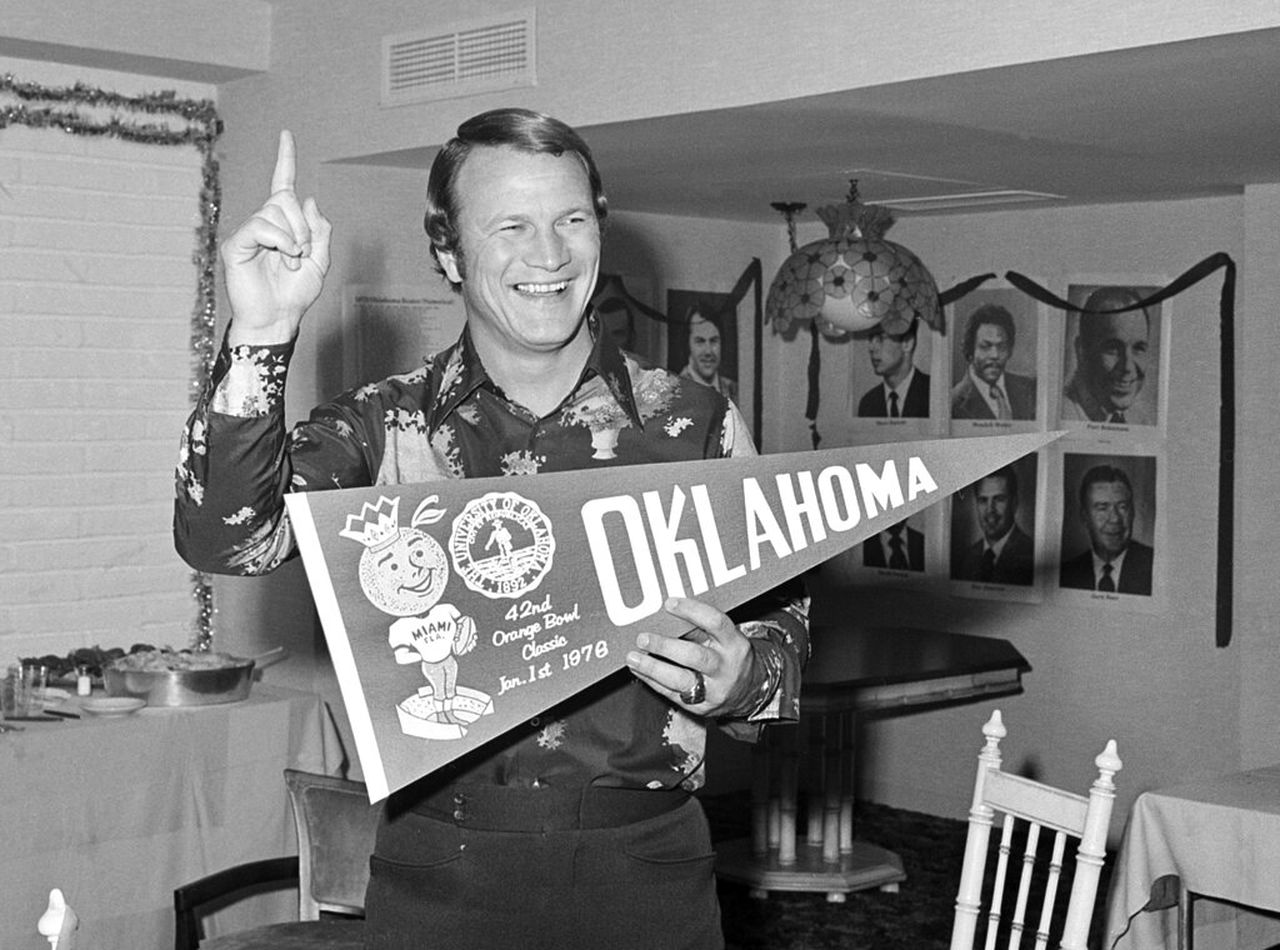
Oklahoma football coach Barry Switzer holds a banner and indicates his Sooners are No. 1 on Jan. 2, 1976, after Oklahoma defeated Michigan in the Orange Bowl in Miami. (AP Photo/File)AP
2. 1976 Oklahoma
Barry Switzer’s Sooners were a juggernaut in the mid-1970s, though NCAA sanctions kept them out of a bowl in the first year and prevented them from achieving pantheon status among the sport’s truly great teams. Oklahoma rolled to an 11-0 record in 1974, finishing No. 1 in the AP poll (they were prevented from being ranked by UPI due to the aforementioned probation). The 1975 Sooners went 11-1 with their only loss 23-3 to Kansas in early November, but again finishing atop the AP rankings (adding the UPI this time) after topping Michigan 14-6 in the Orange Bowl. Oklahoma began the 1976 season with four straight victories before a 6-6 tie with Texas in early October. The Sooners were still in championship contention, however, but not after back-to-back losses to Oklahoma State (31-24) and Colorado (42-31) at the end of the month. The Sooners won their last four games, including a 41-7 demolition of Wyoming in the Fiesta Bowl, to finish 9-2-1 and No. 5 overall. Pittsburgh finished 12-0 and claimed the national championship.
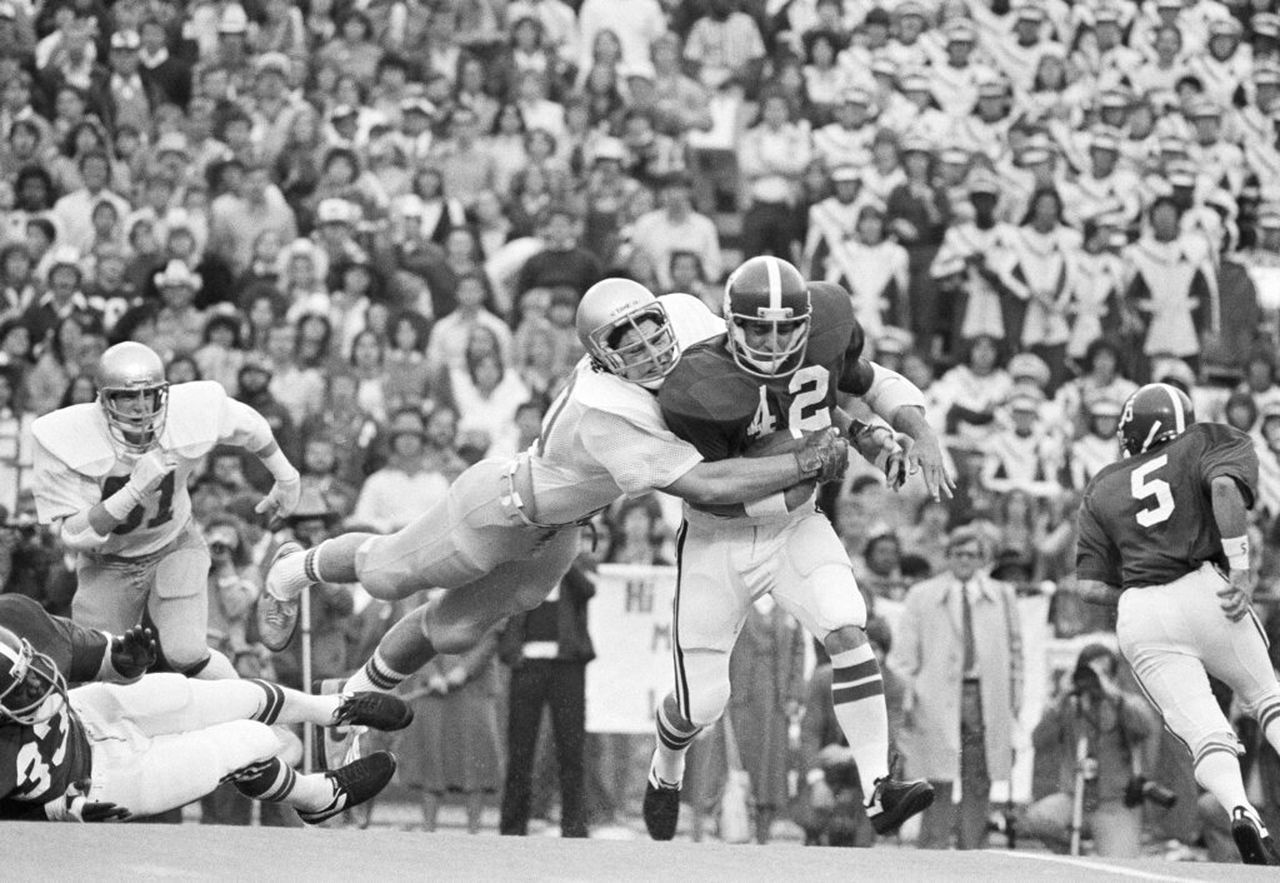
Alabama’s Major Ogilvie (42) picks up short yardage early in the first quarter as Notre Dame’s Scott Zettek (70) hangs on to bring Ogilvie down at Saturday, November 15, 1980 game in Birmingham. (AP Photo/Joe Holloway Jr.)AP
3. 1980 Alabama
The Crimson Tide won back-to-back national titles for the second time under Paul “Bear” Bryant in 1978 and 1979, going 11-1 the first year and 12-0 the second. In 1978, Alabama lost only to USC 24-14 early in the season before winning its final nine games and claiming the AP title (the Trojans were first in the UPI). Capping the season was a 14-7 victory over top-ranked Penn State in the Sugar Bowl, a game made famous by the “Goal Line Stand.” The Crimson Tide ran the table in 1979, including a 24-9 victory over Arkansas in the Sugar Bowl. Alabama entered that game ranked No. 2, but ascended to the top of both polls after No. 1 Ohio State lost 17-16 to USC in the Rose Bowl. The Crimson Tide started the 1980 season 7-0 and was ranked No. 1 when it lost 6-3 to Mississippi State in Jackson on Nov. 1. Two weeks later came a 7-0 loss to Notre Dame, knocking Alabama out of the national title race. The Crimson Tide finished 10-2 and ranked No. 6 after pummeling Baylor 30-2 in the Cotton Bowl, with SEC rival Georgia (whom the Crimson Tide hadn’t played that season) going 12-0 and winning the national championship.
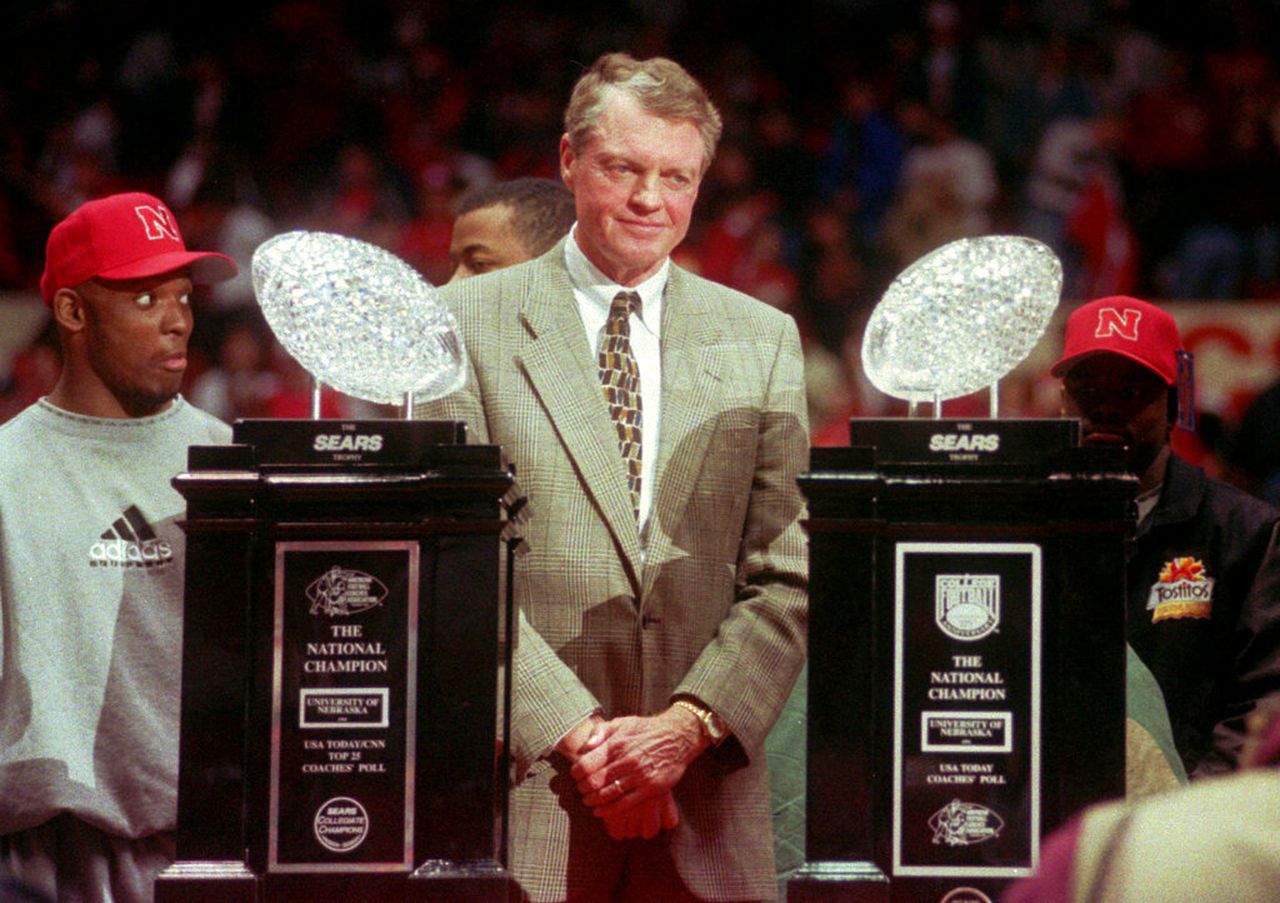
In this Jan. 3, 1996 file photo, Nebraska head football coach Tom Osborne stands between Nebraska’s two National Championship trophies during the homecoming rally at the Devaney Sports Center in Lincoln, Neb. The Huskers won a third national title in 1997. (AP Photo/Dave Weaver, File)AP
4. 1996 Nebraska
After several near-misses, Tom Osborne finally got the Cornhuskers back on top in 1994. Nebraska took over the No. 1 ranking in early November, and ended up atop both polls after beating Miami 24-17 in the Orange Bowl and finishing 12-0. The following year’s team was even better (and is regarded as among the greatest in modern college football history). The Huskers rolled to another 12-0 record, including a 62-24 thrashing of No. 2 Florida in the Fiesta Bowl. The winning streak eventually reached 25 straight games before ending with a 19-0 loss at Arizona State on Sept. 21, 1995. Nebraska made it back to No. 3 in the rankings before losing 37-27 to Texas in the first Big 12 championship game. After a 41-21 win over Virginia Tech in the Orange Bowl, the Cornhuskers finished 11-2 and No. 6 overall (Florida won the national championship that year). The 1997 Nebraska team made it three championships in four years, however, pulling off a 13-0 record to take first place in the coaches poll, with equally unbeaten Michigan claiming the AP championship.
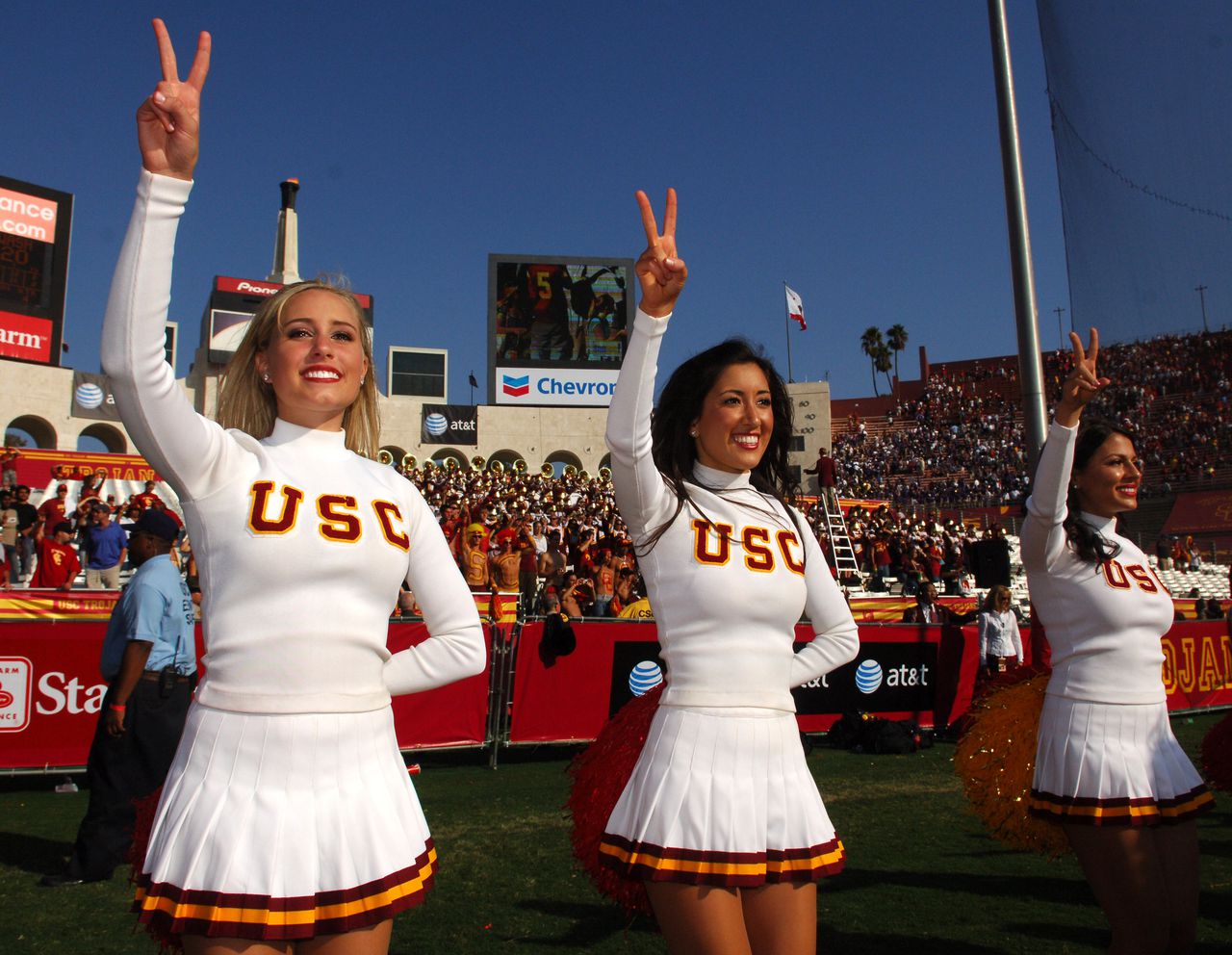
USC Song Girl cheerleaders flash the Fight On sign during 26-20 victory over Washington in Pacific-10 Conference game at the Los Angeles Memorial Coliseum in Los Angeles, Calif. on Saturday, October 7, 2006. (Photo by Kirby Lee/Getty Images)Getty Images
5. 2005 USC
The Trojans emerged from a decade in the doldrums under veteran coach Pete Carroll, winning back-to-back titles in 2003 and 2004 and coming very close to taking home a third. The 2003 team lost in triple-overtime to Cal early in the season, but won its last nine games to finish 12-1 after beating Michigan 28-14 in the Rose Bowl. The Trojans were voted No. 1 in the AP poll, though LSU claimed the BCS national championship by beating Kansas State in the Sugar Bowl (at the time, there was no mechanism to force a matchup between 1 vs. 2 — or 1 vs. 1, as the case may be — for the national title). The BCS included the Big Ten and Pac-10 champions for the first time in 2004, and USC went wire-to-wire as No. 1 and took home its second straight championship after throttling No. 2 Oklahoma 55-19 in the Orange Bowl. (Auburn, also unbeaten, was left out of the BCS title game and had to settle for winning the Sugar Bowl and finishing No. 2). With a stacked team returning the next year, the Trojans were again ranked No. 1 all year and won their first 12 games. That 34-game streak ended with a 41-38 loss to No. 2 Texas in a classic championship game at the Rose Bowl. Years later, USC’s 2004 national title and its 2005 runner-up finish (as well as Reggie Bush’s 2005 Heisman Trophy) were vacated by NCAA sanctions. Still, no team in the modern era has come as close to a three-peat.
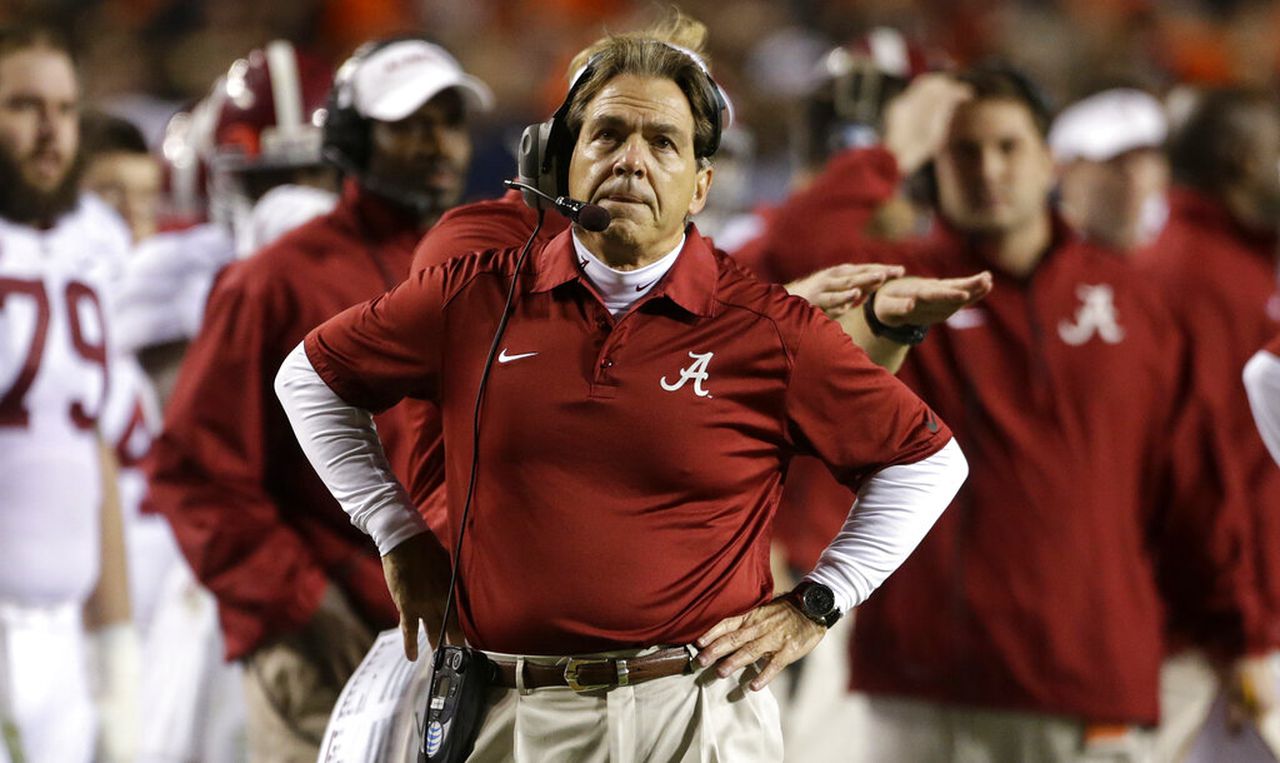
FILE – In this Saturday, Nov. 30, 2013, file photo, Alabama head coach Nick Saban shows frustration near the end of game against Auburn, which Alabama lost 34-28 on the famed “Kick Six” play. (AP Photo/Dave Martin, File)AP
6. 2013 Alabama
The most-recent team to win back-to-back national championships saw its run at a third undone by one of the wildest finishes in college football history. Nick Saban’s 2009 Crimson Tide went 14-0 and won the school’s first national title in 13 years, but slipped back to 10-3 the following year. Led by one of the greatest defenses in modern history, the 2011 Alabama team won its first eight games and was ranked No. 2 headed into an early November showdown with top-ranked LSU in Tuscaloosa. The Tigers won that “Game of the Century” 9-6 in overtime, but Alabama was able to sneak into the BCS title game after Oklahoma State lost to Iowa State in late November. Alabama justified its position by routing LSU 21-0 in the championship game, then started 9-0 in 2012 before losing 29-21 to Texas A&M in November. Alabama got back into the BCS championship game again after beating Georgia in the SEC title game, then buried No. 1 Notre Dame 42-14 for its second straight national championship. The 2013 team kept its No.1 ranking until the regular-season finale vs. Auburn in the Iron Bowl, with the Tigers winning 34-28 on Chris Davis’ famed “Kick Six” missed field goal return on the final play. Alabama then lost 45-31 to Oklahoma in the Sugar Bowl to finish No. 7, with Florida State beating Auburn 34-31 for the BCS title. Saban’s teams have won three more national championships since, winning in 2015, 2017 and 2020, and losing the title game in 2016, 2018 and 2021.
Creg Stephenson has worked for AL.com since 2010 and has covered college football for a variety of publications since 1994. Contact him at [email protected] or follow him on Twitter at @CregStephenson.
